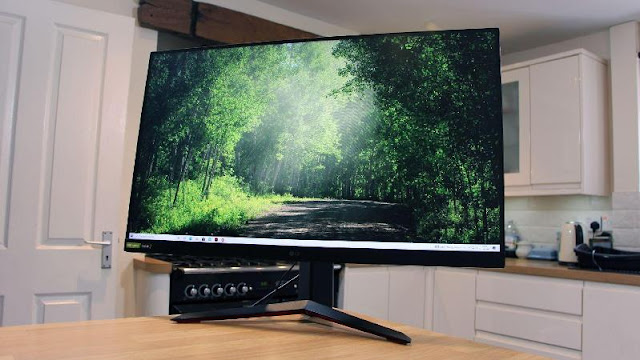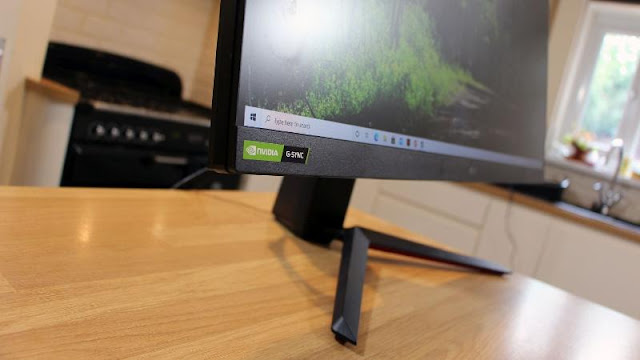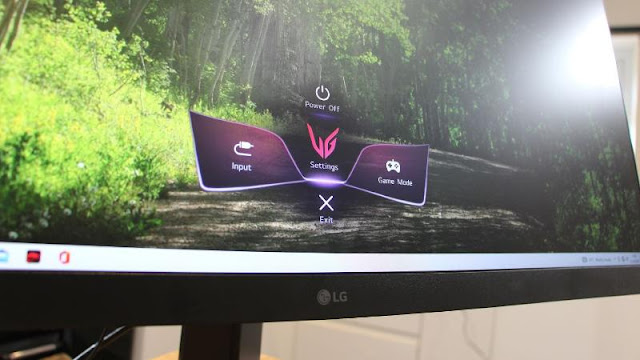The LG UltraGear 32GP850-B delivers superb colours and great mid-market refresh rate performance in a large display with a sensible resolution and design.
Should I Buy The LG UltraGear 32GP850-B?
Pros
- Great colour accuracy: Large, easy to use design
- Impressive mainstream refresh rate ability
Cons
- Mediocre contrast
- Not fast enough for high-end eSports
- Not 4K
Our Verdict
Price When Reviewed
- $599.99
It’s always tempting to shell out for a panel like the LG UltraGear 32GP850-B if you want a big-screen PC gaming experience: its 32in diagonal is big enough to dominate all but the biggest desks, and the LG pairs its impressive size with some high-end specifications in other areas.
The 32GP850-B will set you back £449 in the UK and $476 in the US, though, and that’s money that you could also spend on a gaming display with different and potentially more useful attributes. Let's see if the UltraGear 32GP850-B is the best gaming monitor for you.
Design & Build
- A large panel with a sensible resolution
- Good-looking, with solid connectivity and sensible design
- A slick and easy to use on-screen display
LG’s panel makes a big first impression – a 32in display with a 16:9 aspect ratio looks huge on most desks, and the UltraGear has slim bezels and a dramatic, flared stand with red accents. At the rear, the screen has a huge red ring and the firm's bold gaming logo.
The 32GP850-B has good build quality too. It’s made entirely from plastic, and the panel is reasonably robust – certainly strong enough to find a home on your desk. That said, it’s not free of build issues: the joystick is a bit too flimsy, and the panel wobbles too much if it’s accidentally knocked.
That’s a good start, and the LG is easy to put together. The base and stand use tool-free mechanisms, and the stand can be removed with a single button. The stand also has a loop for cable-tidying, although the ability to route cables through the stand itself would be better.
The display has two HDMI 2.0 ports that are limited to 144Hz alongside one DisplayPort 1.4 connection and two USB 3.2 Gen 1 connectors. The ports are all positioned on the back of the screen and face outwards – so they’re far easier to reach than the downward-facing ports on other screens.
LG’s on-screen display menu is attractive and responsive, and it’s easily navigable thanks to a joystick in the middle of the bottom bezel. It’s well-organised, too – every option is where you’d expect.
Specs & Features
- The 1440p resolution and 165Hz refresh rate deliver good mainstream performance
- It overclocks to 180Hz, and the LG works with AMD and Nvidia graphics cards
- 4K, 240Hz or 360Hz options could be better for your particular needs
LG’s specification ticks most of the boxes required for mainstream gaming. It’s an IPS panel with 10-bit colour, and its resolution of 2560 x 1440 delivers a pixel density of 92ppi – high enough to keep things crisp but modest enough to remain playable on a wide range of graphics cards.
The UltraGear 32GP850-B has a default refresh rate of 165Hz that works with AMD FreeSync and Nvidia G-Sync. It’s got a minor overclock to 180Hz, and there’s a rock-solid response time of 1ms.
In some ways, though, the specification could leave some gamers wanting more. If you want a particularly crisp single-player experience, for instance, then a 4K panel will do the job, even if you need a more powerful graphics card.
And if you want to play high-level eSports games, then you should look for a 240Hz or 360Hz display instead – although you’ll need a powerful GPU for that, too. Also not that 360Hz panels only run at 1080p.
A 240Hz display like the Samsung Odyssey G7 at 1080p will be cheaper than the LG, but if you want to combine 240Hz operation with a 2,560 x 1,440 resolution then expect to pay at least £479 or $594. A 360Hz display like the MSI Oculux NXG253R will cost you at least £549 or $490 and is currently only available at 1080p. And, as we’ve detailed later, a lot of the best alternatives to the LG are even more expensive.
Performance
- Consistently accurate colours
- Good refresh rate and response time performance - this screen is crisp and fast
- Contrast is acceptable, but not brilliant, so the LG lacks a little depth
Out of the box, the LG delivered a reasonable Delta E of 2.29 and a colour temperature of 6,001K. The former result offers enough colour accuracy for any game, and the latter figure is a little cool – but it’s not wayward enough to cause any problems.
The LG displayed 99.8% of the sRGB colour gamut, and the panel rendered an impressive 94.1% of the DCI-P3 colour space. That means the display can produce virtually every colour needed by mainstream games and HDR titles.
Switch over to the LG’s sRGB mode and colour performance improves, with the Delta E revising to 1.09 and the colour temperature at a near-flawless 6,399K. The brightness is lowered in this mode, but the LG still has enough punch to handle everyday gaming.
The UltraGear 32GP850-B delivered great colour performance, but its contrast ability is less impressive. At factory settings the panel’s contrast ratio of 907:1 is middling, and that figure only improved slightly to 943:1 with sRGB mode engaged.
The contrast figures are not disastrous – indeed, they’re reasonable for an IPS panel. In real-world terms, the contrast results are caused by slightly high black points, and that means darker areas in games don’t have quite as much depth or nuance as they do elsewhere.
But the LG’s slight lack of contrast doesn’t ruin gaming, and you’ll still get a vibrant and engaging experience, even if it could do with more intensity. Ultimately, an IPS gaming panel should be hitting a contrast ratio beyond 1,000:1, and a VA display will have far greater contrast, albeit often at the expense of colour accuracy.
LG’s panel does a good job with fast-moving games. At its default 165Hz setting the display is easily sharp enough to handle mainstream gameplay, and the move up to 180Hz provides a minor improvement without introducing any issues like ghosting or blurring.
Ultimately, though, the 32GP850-B delivers smooth, fast, and crisp gameplay at 165Hz and 180Hz and with all three of those modes engaged – you’ve got to be looking really closely to spot faults. Whatever you pick, you’re going to get good performance.
Don’t expect this display to deliver good HDR content, though. While LG does boast that this screen supports HDR10 content, its maximum brightness of 407 nits isn’t high enough to deliver the punch required, and the panel has no fancy dimming. You’ll have to spend more to get good results.
Price & Availability
LG’s display costs £449 in the UK via Overclockers and US$476 in the US at Newegg - down from the $599.99 RRP. You can also buy it from Currys, Amazon and eBuyer in the UK.
In the US, you can also head to Amazon and Walmart. Note that some retailers don't have the 'B' on the end of the model number but it is the same monitor.
That’s certainly not extortionate, but you can find this kind of specification for below £450 or $450 if you shop around. If you’re willing to forego IPS and buy a VA panel instead, expect that figure to drop below £400 or $400, but be aware that you won’t necessarily get the LG’s colour accuracy.
If you’d rather have a display with a 4K resolution, then consider the AOC U28G2XU. That panel is smaller than the LG, but it pairs its 4K resolution with a 144Hz refresh rate and costs £582 in the UK and a similar amount in the US.
Our 240Hz and 1440p display choice is the Samsung Odyssey G7, but its 32in version costs £620/$799 and the 27in model costs £549/$611. If you want to step up to 360Hz, expect to pay £699 or $490 for the MSI Oculux NXG253R and its 1080p resolution.
If you're still unsure, head here for our chart of the best monitors for every budget.
Verdict
The LG UltraGear 32GP850-B doesn’t have the specification to compete with specialist rivals, and its contrast performance is average rather than great – but don’t let that put you off.
This display still has good enough contrast to make games look decent, and it pairs that with excellent colour reproduction alongside a large diagonal and good resolution – and a refresh rate that will handle any mainstream single-player or esports situation. The LG has some decent features, and its impressive OSD and port placement make this screen easy to use.
This panel doesn’t veer off into a specialism like many of its competitors but instead delivers rock-solid mainstream performance, and so it’s a good choice if you want a versatile panel for all sorts of gaming situations.
Specs
- Panel size: 32in (81cm)
- Resolution: 2,560 x 1,440
- Display Technology: IPS
- Aspect Ratio: 16:9
- Response Time (GtG): 1ms
- Maximum Refresh: 180Hz (with adaptive sync)
- HDR: HDR10
- Video Ports: 2 x HDMI, 1 x DisplayPort
- USB Ports: 2 x USB 3.2 Gen 1
- Speakers: n/a
- Other Ports: Headphone jack
- Typical Brightness: 350 nits
- Static Contrast: 700:1
- Variable Sync: AMD FreeSync/Nvidia G-Sync
- Weight: 7.2kg









0 comments:
Post a Comment